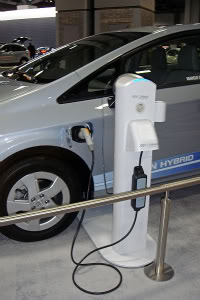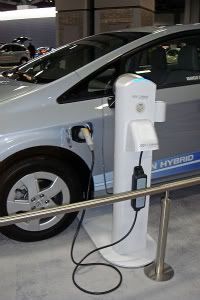Electric Vehicle Charging Solutions – Where Does "Better Place" Fit?

I notice that Shai Agassi of Project Better Place was interviewed on NPR again this morning. Holy cow, that guy has wonderful PR; it’s hard to turn around without running into him presenting his idea (ubiquitous electric vehicle battery swapping stations).
But does it seem practical for a landmass the size of the US? Agassi’s talking point is the “ABCs” of EVs: Automobiles, Batteries, and Charging, in which he reminds us that all the money we’ve invested in the first two will not win the day if we fail to deal properly with the third. Of course this is true – and battery swapping is a wonderful solution for certain parts of the world, e.g., countries like Israel (its first customer). Israel is extremely dense, and surrounded by oil-rich enemies.
I’m no fan of big oil myself, but I just can’t see battery swapping stations all over a landmass like the continental US — 3.5 million square miles, 600 times the size of Israel. And I certainly don’t buy the idea that the entirety of the charging infrastructure has to be in place before consumers will accept EVs.
Far more credible, in my opinion, is the following scenario:
a) The introduction of EVs will happen gradually, starting with early adopters whose life styles are a good fit for electric transportation: multi-car families with an available place to charge at night, and one car primarily used to commute within a local region.
b) While this is playing itself out over a period of years, OEM production volume will be ramping, quality issues will be resolving, battery technology will improve and costs will fall. Simultaneously, we’ll see the construction of charging stations at the workplace, movie theaters, etc.
c) The replacement of all internal combustion engine-based cars and trucks (230 million in the US) will require several decades, and will happen with fast-charging (“Level 3,” high-power charging) – probably delivered using the infrastructure of filling stations.
d) In the meanwhile, Better Place will be incorporated into geographies in which it makes sense.
Having said all this, I sure wish I could afford 1/100th the PR horsepower of Agassi — a true business visionary who hasn’t overlooked what it takes to get his story told.


The “Caboose” fast charging station for Electric Cars.
This might make a very profitable program as it provides “Quick” recharging for capable EVs especially along the highways. and this is not as yet being widely implemented, unless you consider less than a dozen quick charging stations in the USA at this time!
A scheme whereby just a mid size trailer (Say 30 ft long) could contain several large packs of high current lead-acid batteries and chargers, to charge them without disrupting the local electric utility grid.
I don’t see long lines of EV at recharging stations for a couple more years so dump charging them is quick enough and a several hour recharge of the packs in the trailer could still handle recharging 8 to 10 EV each day per each pack in the trailer. Styling the trailer distinctively like a train caboose perhaps and painted red so EV drivers could easily spot them. (When I say “Trailer” I actually mean a used ocean shipping container, often used for storage. A good combination might be a 30 ft long base unit with mini-office, and restroom in it and most of the chargers and batteries inside also. Then add a short “Ten ft.” unit centered on top for “Sign” and more battery storage. Then level I and II “Charging Stations” could be set-up on an area near by, or adjacent to the “Caboose” and wired underground to it. And the “Fast Charge Stations” might be fastened right on the outside of the Caboose to keep the wiring very short and efficient. A trained Attendant will probably be required initially.
Might be a good transitional business leasing space at existing gas stations or selling /leasing the “EV Charging Caboose ” to Fuel sales operators. (They are in business to make money!) Could be a viable business and might cost less than the $50K to set up a commercial EV recharger station for retail sales. As has been suggested; as the cost to add EV charging to present gas sales stores. I think of it as a five to ten year transitional program replaced after at the most 20 years by permanent structures at major highway intersections.
In the short run, people using the high-power charger will be few and far between. So it makes more sense for these early charging stations to have a dump pack, so they can use a low-capacity electric service. Later on, when that station is used a dozen times a day, *then* upgrade its electrical service.
Even with high-power electric utility service, a dump pack still has advantages. Think about how people use gas stations. They park at the pump, start it, and then go inside to buy a treat, etc. The car may get fuelled for 5 minutes, but sit there for 10 minutes. With a local dump pack, this 50% duty cycle cuts the peak electric load in half. And thus lowers the peak demand on the power grid and that reduces cost of the Electrical power.
Regards,
Dennis Lee Miles
E-Mail: EVprofessor@E-V-T-I-Inc.com
Phone: 1 (813) I D 4 – E V T I or 1[813]434-3884
Located in the: Tampa Bay, Florida